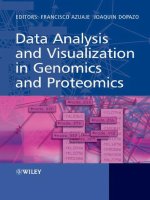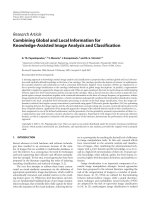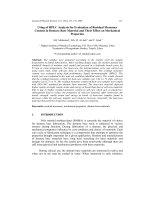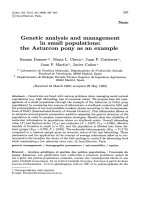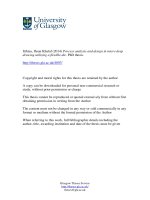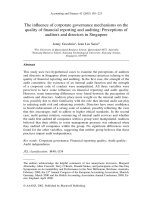Aerobiology, image analysis and allergenicity of pollen and spores in singapore
Bạn đang xem bản rút gọn của tài liệu. Xem và tải ngay bản đầy đủ của tài liệu tại đây (2.42 MB, 286 trang )
AEROBIOLOGY, IMAGE ANALYSIS AND ALLERGENICITY
OF POLLEN AND SPORES IN SINGAPORE
ONG TAN CHING
NATIONAL UNIVERSITY OF SINGAPORE
2004
AEROBIOLOGY, IMAGE ANALYSIS AND ALLERGENICITY OF ONG TAN CHING 2004
POLLEN AND SPORES IN SINGAPORE
AEROBIOLOGY, IMAGE ANALYSIS AND ALLERGENICITY
OF POLLEN AND SPORES IN SINGAPORE
ONG TAN CHING
B. Sc. (Honours), Universiti Putra Malaysia
A THESIS SUBMITTED
FOR THE DEGREE OF DOCTOR OF PHILOSOPHY
DEPARTMENT OF PAEDIATRICS
NATIONAL UNIVERSITY OF SINGAPORE
2004
i
Acknowledgements
I would like to thank my supervisors, Adjunct Associate Professor Lee Bee Wah,
Associate Professor Hugh Tan Tiang Wah and Dr. Chew Fook Tim for their immense
support, guidance and patience during the course of my study and the opportunity to
undertake this project not forgetting Associate Professor Tan Teck Koon with his
valuable advice on mycology based work.
I would like to thank Wang Xiaoshan for being my mentor in statistics and Wong Fei
Ling for teaching me the ropes in mycological research and Dr. Adrian Loo, Dr. Bi
Xuezhi and Dr. Shang Huishen for the guidance and helpful problem solving
suggestions.
I am also very grateful to Ong Seow Theng, Tan Teng Nging, Wang Wun Long, Hon
Sook Mei, Kuay Kuee Theng and Hao Jing for their relentless encouragement and the
laughter and pain shared during the process of pursuing their graduate studies. I
would also like to extend my gratitude to my colleagues especially Lim Puay Ann and
those working in the Functional Genomics Laboratory 1 and 3 for the wonderful
experience working together and their never failing encouragement and support.
I would also like to specially thank T. Morgany for helping me out with the airspora
traps, sample collections and preparation for the image analysis.
Finally, my thanks to my family who provided me with unconditional love and
support to undertake this challenge and complete it to what it is today.
ii
Table of Contents
Page
Acknowledgements
Table of contents
List of figures
List of tables
List of abbreviations
Summary
CHAPTER 1: INTRODUCTION
1.1 ALLERGY
1.1.1 Hypersensitivity
1.1.1.1 Allergy ─ Type I hypersensitivity
1.2 ALLERGENS
1.2.1 Fungal allergenicity
1.2.2 Pollen allergenicity
1.2.2.1 Tree pollen allergenicity
1.2.2.2 Dicotyledonous weed pollen allergenicity
1.2.2.3 Grass pollen allergenicity
1.2.3 Fern allergenicity
1.3 TRENDS IN ALLERGIC DISEASES
i
ii
ix
xii
xiv
xvi
1
1
1
3
3
6
7
8
9
11
12
iii
CHAPTER 2: AEROBIOLOGY IN SINGAPORE
2.1 INTRODUCTION
2.1.1 Singapore
2.1.2 Airspora
2.1.2.1 Fungal spores
2.1.2.2 Fern spores
2.1.2.3 Pollen
2.1.3 Technical factors influencing aispora quantification
2.1.4 Effects of airspora counts on health
2.1.5 Aims
2.2 MATERIALS AND METHODS
2.2.1 Airspora sampling and meteorological data
2.2.2 Evaluation and optimisation of screening factors
2.2.3 Seasonal patterns
2.2.4 Diurnal patterns
2.2.5 Statistical analyses
2.3 RESULTS
2.3.1 Evaluation and optimisation of screening factors
2.3.1.1 Screening magnifications
2.3.1.2 Position of traverses
2.3.1.3 Number of traverses
2.3.1.4 Orientation of traverses
14
14
15
16
16
16
17
18
19
20
22
23
23
24
24
25
25
26
iv
2.3.2 Seasonal patterns
2.3.2.1 Fungal spores
2.3.2.2 Unidentified fungal spore
2.3.2.3 Pollen
2.3.2.4 Fern spores
2.3.2.5 Comparisons of counts between different stations
2.3.2.6 Association with meteorological variables
2.3.3 Diurnal patterns
2.3.3.1 Fungal spores
2.3.3.2 Pollen
2.3.3.3 Fern spores
2.3.3.4 Association with meteorological parameters
2.4 DISCUSSION
2.4.1 Evaluation and optimisation of screening factors
2.4.2 Seasonal and diurnal patterns
2.4.2.1 Fungal spores
2.4.2.2 Pollen
2.4.2.3 Fern spores
2.4.3 Comparison of counts between different stations
2.5 CONCLUSIONS
26
26
34
36
36
37
38
47
47
50
53
53
58
60
60
64
67
68
69
v
CHAPTER 3: IDENTIFICATION OF AIRSPORA
COMPONENTS BY IMAGE ANALYSIS
3.1 INTRODUCTION
3.1.1 Shortcomings of current airspora quantification methods
3.1.2 Pollen grain identification
3.1.3 Fern spore identification
3.1.4 Fungal spore identification
3.1.5 Aims
3.2 MATERIALS AND METHODS
3.2.1 Samples preparation
3.2.2 Image capture
3.2.3 Features measurement
3.2.4 Statistical analyses
3.3 RESULTS
3.3.1 Local airspora
3.3.2 Grass (Poaceae) pollen
3.3.3 Asteraceae weed pollen types
3.3.4 Olea look-alike pollen types
3.3.5 All pollen types
3.3.6 Cluster analyses
3.4 DISCUSSION
3.5 CONCLUSIONS
70
72
72
73
73
74
77
77
78
80
86
92
98
104
110
115
119
vi
CHAPTER 4: DEVELOPMENT OF A DOT
IMMUNOARRAY SYSTEM FOR
SIMULTANEOUS DETECTION OF A LARGE
ARRAY OF ALLERGEN-SPECIFIC IGE
MOLECULES
4.1 INTRODUCTION
4.1.1 Techniques in allergy diagnosis
4.1.2 Measurement of IgE levels
4.1.3 Advantages of in vitro techniques
4.1.4 Limitations of the available techniques and aims of the
study
4.1.5 Aims
4.2 MATERIALS AND METHODS
4.2.1 Dotting apparatus
4.2.2 Support materials and washing buffers
4.2.3 Loading efficiency of the 384-pin MULTI-BLOT
replicator
4.2.4 Allergen extracts
4.2.5 Allergen array for the detection of specific IgE
4.2.6 Patients and sera
4.2.7 Allergen array validation
125
126
127
128
128
129
129
130
130
131
135
135
vii
4.2.8 Statistical analyses
4.3 RESULTS
4.3.1 Support materials, washing buffer and loading efficiency
4.3.2 Performance of allergen array
4.3.3 Allergen array validation
4.3.3.1 Immunoarray versus ELISA
4.3.3.2 Immunoarray versus UniCAP
4.4 DISCUSSION
4.5 CONCLUSIONS
CHAPTER 5: AIRSPORA ALLERGY IN
SINGAPORE
5.1 INTRODUCTION
5.1.1 Prevalence of airspora allergies
5.1.2 Aims
5.2 MATERIALS AND METHODS
5.3 RESULTS
5.3.1 Detected frequencies of specific IgEs to airspora allergens
5.3.2 Cluster analyses
5.4 DISCUSSION
5.5 CONCLUSIONS
137
139
142
149
149
149
153
156
158
160
160
161
167
175
190
viii
CHAPTER 6: SIGNIFICANCES, SUMMARY
AND FUTURE RESEARCH WORK
REFERENCES
APPENDICES
191
195
i - xxx
ix
List of figures
Figure 1.1 Proposed cellular and molecular mechanism of allergy.
Adapted from Holgate (1999).
Figure 2.1 Locations of the sampling and meteorological stations.
Figure 2.2 Slide screening methods used: (A) five horizontal
traverses (3 mm apart) and (B) 12 vertical traverses (4 mm apart).
Orientation of traverses: Longitudinal = L and transverse = T.
Figure 2.3 Scatter plots and comparisons of counts made at 250 and
400 magnifications for a) all airspora types, b) airspora <200m
2
in size
and c) airspora >200m
2
in size using Spearman’s Correlation Test
(Correlation coefficient = r) and Wilcoxon Rank Test. p-value:
p<0.001***, p<0.01**, p<0.05* .
Figure 2.4 Examples of fungal spore counts <200 m
2
in area
screened at 250 and 400 magnifications.
Figure 2.5 Comparisons of airspora counts at different horizontally
positioned traverses (H1 to H5) along the length of the slide using the
Wilcoxon Rank Test. a) all airspora types, b) airspora <200m
2
and c)
airspora >200m
2
. p-value: p<0.001***, p<0.01** and p<0.05*.
Figure 2.6 Scatter plots and count comparisons for different numbers
of screening traverses for all airspora types using Spearman’s Correlation
Test (correlation coefficient = r) and Wilcoxon Rank Test. p-value:
p<0.001***, p<0.01** and p<0.05*.
Figure 2.7 Scatter plots and count comparisons using different
numbers of screening traverses for airspora <200 m
2
in area size using
Spearman’s Correlation Test (correlation coefficient = r) and the
Wilcoxon Rank Test. p-value: p<0.001***, p<0.01** and p<0.05*.
Figure 2.8 Scatter plots and count comparisons using different
numbers of screening traverses for airspora >200m
2
in area size using
the Spearman’s Correlation Test (correlation coefficient = r) and the
Wilcoxon Rank Test. p-value: p<0.001***; p<0.01** and p<0.05*.
Figure 2.9 Scatter plots and count comparisons from horizontal and
vertical traverses using the Spearman’s Correlation Test (correlation
coefficient = r) and the Wilcoxon Rank Test. p-value: p<0.001***,
p<0.01** and p<0.05*.
Figure 2.10 Seasonal patterns of major fungal spores from the Kent
Ridge Station. Fungal spore counts are in number of fungal spores m
3
day
-1
.
Page
2
20
21
27
28
29
30
31
32
33
41
x
List of figures
Figure 2.11 Photomicrographs of unknown spore “kuaci”
Figure 2.12 Seasonal patterns of the ascospore ‘kuaci’ from the Kent
Ridge Station.
Figure 2.13 Seasonal patterns of pollen types and airspora from the
Kent Ridge Station. Pollen counts are in number of pollen grains m
3
day
-
1
.
Figure 2.15 Seasonal patterns of fern spores from 1991 to 1995 at the
Kent Ridge Station. Fern spore counts are in number of fern spores m
-3
day
-1
.
Figure 2.16 Diurnal calendars for Cladosporium spp., Didymosphaeria
sp. and the ascospore ‘kuaci’ for 1995, 1996, 1997 and average of all 3
years.
Figure 2.17 Diurnal calendars for Curvularia spp., Pithomyces sp. and
Dreschlera-like spores for 1995, 1996, 1997 and average of all 3 years.
Figure 2.18 Diurnal calendars for Casuarina equisetifolia, Kyllingia
polyphylla and Poaceae for 1995, 1996, 1997 and average of all 3 years
at the Kent Ridge Station.
Figure 2.19 Diurnal calendars for Acacia spp. and Elaeis guineensis
for 1995, 1996, 1997 and average of all 3 years at the Kent Ridge Station.
Figure 2.20 Diurnal calendars for Nephrolepis auriculata,
Dicranopteris curranii and Dicranopteris linearis for 1995, 1996, 1997
and average of all 3 years at the Kent Ridge Station.
Figure 2.19 Diurnal calendars for Asplenium nidus, Pteridium
aquilinum and Stenochlaena palustris for 1995, 1996, 1997 and average
of all 3 years at the Kent Ridge Station.
Figure 3.1 Results of the cluster analyses of all pollen types.
Figure 3.2 Photomicrographs of the local airspora studied.
Figure 3.3 Photomicrographs of the Poaceae pollen studied.
Figure 3.4 Photomicrographs of the Asteraceae pollen studied.
Figure 3.5 Photomicrographs of the Olea look-alike pollen studied.
Page
35
42
43
44
48
49
51
52
55
56
111-114
121
122
12
124
xi
List of figures
Figure 4.1 Image processing sequence of the immunoarray
membranes.
Figure 4.2 Effects of different concentrations of Tween 20 detergent
in PBS washing buffer. Means and SD (error bars) are shown.
Figure 4.3 Optical density readings of the protein dots (BSA) at
different concentrations. Maximum, minimum, means and SD (error bar)
of dots are shown.
Figure 4.4 Examples of intra-membrane and inter-membrane
concordance bi-plots.
Figure 4.5 Correlation of the ELISA versus immunoarray system.
Figure 5.1 Prevalence of specific IgE molecules detected to different
types of allergens.
Figure 5.2 Reactions to cultivated plant, weed and grass pollen in
descending order for each family or subfamily.
Figure 5.3 Reactions to tree pollen in descending order for each
family.
Figure 5.4 Reactions to fungal allergens in descending order for each
class.
Figure 5.5 Bi-plots of some local pollen with other allergens.
Correlations were obtained by the Kendall correlation test. All
correlations were significant at p value less than 0.001.
Figure 5.6 Results of cluster analysis (Cluster 1) for pollen and food-
based allergens.
Figure 5.7 Results of cluster analysis (Cluster 2) for pollen and food-
based allergens.
Figure 5.8 Cluster analysis for fungal allergens.
Figure 5.9 Bi-plots of reaction intensities between strongly correlated
fungal allergens. Correlation coefficients, r were obtained
from Kendall correlation test with p values less than
0.001.
Page
135
140
140
142-143
151
163
164
165
166
168-169
170
171
173
174
xii
List of tables Page
Table 1.1 Allergenic fungi. Adapted from Vijay and Kurup (2004).
Table 1.2 Grasses and their subfamilies. Adapted from Esch (2004) and
Soreng et al. (2004).
Table 2.1 Spearman’s correlation coefficients for airspora counts
between 1991 to 1995 for the Kent Ridge Station.
Table 2.2 Spearman’s Correlations Coefficients of airspora counts
between the sampling stations at Clementi, Hougang and Kent Ridge.
Table 2.3 Spearman’s correlation coefficients between airspora counts
and meteorological factors from 1991 to 1996 at the Kent Ridge Station.
Table 2.4 Correlations of diurnal counts of airspora with meteorological
factors.
Table 3.1 Airspora studied.
Table 3.2 Primary and secondary morphological parameters measured
using the Olympus MicroImage software (Media Cybernetics, 1999).
Table 3.3 Identification accuracies of the local airspora using step-wise
canonical discriminate analysis.
Table 3.4 Canonical discrimination coefficients for the local airspora.
Table 3.5 Means of important parameters used in local airspora
identification.
Table 3.6 Identification accuracies of grass pollen types by step-wise
canonical discriminate analysis.
Table 3.7 Canonical discrimination coefficients for grass pollen types.
Table 3.8 Means of important parameters used in grass pollen
identification.
Table 3.9 Identification accuracies of the Asteraceae weed pollen types
by step-wise canonical analysis.
Table 3.10 Canonical discrimination coefficients for the Asteraceae
weed pollen types.
Table 3.11 Means of important parameters used in identification of the
Asteraceae pollen types.
5
10
39-40
45
46
57
75-76
79
82
83-84
85
88
89-90
91
94
95-96
97
xiii
List of tables
Table 3.12 Identification accuracies of the Olea look-alike weed pollen
types by step-wise canonical analysis.
Table 3.13 Canonical discrimination coefficients for the Olea look-alike
pollen types.
Table 3.14 Means of important parameters used in identification of the
Olea-look alike pollen types.
Table 3.15 Pollen types and their classification accuracies in percentage
ranges by step-wise canonical discriminate analysis.
Table 3.16 Canonical discrimination coefficients for all pollen types.
Table 4.1 Allergen sources dotted onto the array.
Table 4.2 Coefficients of variation of each pin on the 384-pin replicator.
Table 4.3 Intra-membrane and inter-membrane concordances.
Table 4.4 Validation results between the immunoarray method versus
the ELISA system. Allergens are arranged in descending order of
concordance.
Table 4.5 Validation results between the immunoarray method versus
the UniCAP system. Allergens are arranged in descending order.
Table 5.1 List of allergens tested and possible local sensitisers.
Table 5.2 Allergy tests performed in Singapore.
Table 5.3 Percentages of concordance between positive results and
bromelain in descending order.
Page
100
101-102
103
105
106-109
132-133
141
144-148
150
152
176
178
186-189
xiv
List of Abbreviations
Chemicals and Reagents
AP buffer buffer for alkaline phosphatase
BCIP 5-bromo-4-chloro-3-indolyl phosphate
BSA bovine serum albumin
NBT nitroblue tetrazolium
PBS phosphate-buffered saline
PBS-BSA phosphate-buffered saline with 1% bovine serum albumin (w/v)
PBS-milk phosphate-buffered saline with 4% skim milk (w/v)
PBS-T phosphate-buffered saline with 0.05% Tween 20 (v/v)
Units and Measurements
cm centimeter
m meter
l microliter
m micrometer
m
2
micrometers square
m
3
micrometers cube
mm milimeter
pollen cm
-3
day
-1
pollen grains per cubic meters per day
spores cm
-3
day
-1
spores per cubic meters per day
OD optical density
xv
Others
ELISA Enzyme-linked immunosorbent assay
FAST Fluorescent allergosorbent test
IgE Immunoglobulin E
MicroImage Olympus MicroImage
TM
OD Optical density
RAST Radio allergosorbent test
SD Standard deviation
SPT Skin prick test
xvi
Summary
An optimal method for screening Singapore’s outdoor airspora samples captured by
the Burkard 7-day volumetric spore trap was developed and consists of screening
slide mounted tapes via three longitudinal traverses, 3 mm apart starting from the
middle of the slide viewed with 400 magnification but 12 vertical traverses can be
employed when diurnal patterns are of interest. Peak fungal spore counts were
observed annually from February to March and October to November. The majority
of the pollen count peaks are in November to March but a mid-year peak was
observed for Acacia auriculiformis and Casuarina equisetifolia. The major peak
period for fern spore counts was found to be from May to August. Diurnal patterns
were also observed in our local airspora. High levels of ascospores were found during
the night while Deuteromycetes spore counts were high during the late morning to
early evening. Pollen and fern spore counts were high during the middle of the day.
Correlations with meteorological parameters were also observed for daily and diurnal
patterns. During the screening process, a previously unidentified fungal spore (with
affinities to Dothideomycetes and Chaetothyriomycetes based on DNA information)
that made up a large proportion of the outdoor and even indoor airspora, was
discovered.
It has been demonstrated that image analysis coupled with light microscopy is a
feasible and useful approach for developing an automated airspora quantification
system. Local airspora and closely related pollen types that are quite similar
morphologically can be satisfactorily differentiated.
xvii
An immunoarray has been developed to simultaneously screen specific IgEs to a large
panel of allergens ranging from those of mites, pollen, fungi, epithelial tissues/dander,
venom and even food. It has been shown that the immunoarray is a useful
semiquantative tool to be used for mass screening purposes.
The development and subsequent use of the immunoarray to screen for the prevalence
of airspora allergens has provided us with important information. Results obtained
from screening studies seem to suggest an under recognition of pollen and spore
allergens in Singapore because a large panel of foreign spores and pollen were also
included in the screens and some reactions to the foreign airspora were higher than
those found locally. This has demonstrated to us the existence of other allergenic
local airspora that were not captured in the sampling trap. Possible cross-reactivity
patterns were observed in more pollen types than fungal allergens. However, for
pollen types the patterns were partly confounded by the absence of a candidate
primary local sensitizer.
In conclusion, new and useful information has been obtained from the work done.
The study has provided useful solutions and answers and suggested much future work
that can be done to understand allergy better in Singapore.
1
CHAPTER 1: INTRODUCTION
1.1 ALLERGY
1.1.1 Hypersensitivity
When an adaptive immune response is mounted excessively or in an exaggerated
form, the term “hypersensitivity” is applied (Roitt et al., 2001). A normal immune
system is beneficial to the body. However, in the case of hypersensitivity the immune
system behaves inappropriately and can result in inflammation and cellular damage.
Hypersensitivity can be divided into four categories viz., types I, II, III and IV
(Coombs and Gell, 1975). Type V hypersensitivity, termed “stimulatory” was later
added. Type I, II, III and V are mediated by antibodies. Type IV hypersensitivity is a
delayed reaction involving a cell-mediated immune response rather than a humoral
response.
1.1.1.1 Allergy ─ Type I hypersensitivity
The term “allergy” is basically used to refer to a type I immediate hypersensitivity
reaction (Roitt et al., 2001). Allergic individuals will produce immunoglobulin E
(IgE) upon contact (with prior sensitization) with an antigen, termed as an allergen
(Figure 1.1). IgE binds to the IgE-specific Fcε receptors of mucosal and cutaneous
mast cells and circulating basophils (von Bubnoff et al., 2003; Kay, 2000). This
reaction occurs within minutes upon re-exposure to the allergen in an allergic
individual. Cross-linking occurs when an allergen binds to an IgE variable region of
two adjacent antibodies on mast cells or basophils. This causes rapid uptake of
2
calcium ions into the mast cells resulting in degranulation and release of
proinflammatory mediators like histamine, leukotrienes, prostaglandins and tryptase.
These, in turn, result in the symptoms of immediate allergic reactions. The mast cells
can also contribute to delayed reactions four to eight hours after the immediate
response. Interleukin-4 (IL-4) has autocrine effects and provides positive feedback to
the T helper 2 (Th2) lymphocytes resulting in the production of more IgEs.
Figure 1.1: Proposed cellular and molecular mechanism of allergy. Adapted from
Holgate (1999).
At the same time, mast cell-derived mediators cause endothelial cells to upregulate
their expression of adhesion molecules for eosinophils, basophils and lymphocytes
(Platts-Mills, 2001, Kay, 2000). Pro-inflammatory mediators like tryptases may
activate the proteinase-activated receptor-2 on endothelial cells resulting in increased
vascular permeability. The recruitment of lymphocytes occurs during the symptom-
free period. They then release cytokines and proteases causing damage in tissues and
finally contributing to what is termed the late-phase reaction. This is expressed as
Allergen
+
+
Y
Y
─
─
IL-12
IL-10
IL-4
IL-13
IL-3, IL-5
GM-CSF
IL-3, IL-4
IL-6, IL-9
─
IFN-γ
+
IL-12
Bacteria
Viruses
Mast
cell
Dendritic cell Th1 cell Eosinophil
Inflammatory
mediators
Dendritic cell Th2 cell B cell
I
g
E
3
congestion in allergic rhinitis and bronchial obstruction or inflammation in asthma.
Chronic inflammation eventually causes airway hyperresponsiveness.
1.2 Allergens
Allergens are antigens that stimulate the allergic reaction (Blumenthal and Rosenberg,
1999). Commonly inhaled allergens that result in the manifestation of allergic disease
can be divided into indoor and outdoor allergens (Kerkhof et al., 2003; Burge and
Rogers, 2000; Boulet et al., 1997; Sporik et al., 1996). Mites, fungi and endothelial
tissues/dander from pets are common indoor allergens (Kerkhof et al., 2003; Boulet et
al., 1997; Sporik et al., 1996). For outdoor allergens, pollen and fungal spores
dominate (Burge and Rogers, 2000; Boulet et al., 1997; Sporik et al., 1996). The
work involved in this thesis focuses on outdoor allergens.
1.2.1 Fungal allergenicity
Fungi constitute a very large group of organisms virtually found in every ecological
niche (Hawksworth, 2001). It is estimated that 1.5 million species of fungi exist
worldwide (Alexopoulos et al., 1996). Fungi are heterotrophic organisms devoid of
chlorophyll, have cell walls made of chitin, are non-motile and reproduce by spores.
Fungi are usually filamentous and multicellular. The filaments termed hyphae
constitute the body (soma) of a fungus which elongates by apical growth. The
reproductive structures differentiate from somatic structures. Most fungi reproduce
sexually by meiosis, producing spores in or on a specialized structure like the
4
basidium or ascus, respectively. These types of fungi are referred as Fungi Perfecti.
Until recently, fungi that lack sexual reproductive structures altogether and make only
mitospores or no spores at all were segregated in the Fungi Imperfecti or
Deuteromycota (Hawksworth 2001; Taylor et al., 1999; Reynolds and Taylor, 1993).
However, the analysis of nucleic acid variation has enabled the classification of
mitosporic fungi with their meiosporic relatives (Agerer, 2003; Taylor, 1995). To
avoid confusion and for the ease of review and discussion in this thesis, the older
taxonomic classification which includes Deuteromycota will be used since a large
number of past and current literature on fungi, especially those in relation to allergy,
still refer to the older classification system.
Fungal spores have long been identified as one of the sources of indoor or outdoor
allergies (Perzanowski et al., 1998; Platts-Mills et al., 1996). Fungal spores owing to
their smaller size can penetrate into the lower respiratory tract resulting in allergies
(Reponen et al., 2001; Lehrer et al., 1983). The manifestation of a fungal allergy
ranges from the common conjunctivitis, rhinitis and rhinoconjunctivitis to the more
detrimental in ascending order of severity, i.e., sinusitis, asthma, bronchopulmonary
mycoses, hypersensitivity pneumonitis and allergic alveolitis (Fink, 1998; O’Hollaren
et al., 1991; Lehrer et al., 1983; O’Brien et al., 1978). Fungi have also been
demonstrated to affect human lives by producing metabolites that are toxic to humans
and animals. The allergenic fungi and their major grouping is shown in Table 1.1.
5
Table 1.1: Allergenic fungi. Adapted from Vijay and Kurup (2004).
Phycomycetes
Mucor
Phytophtora
Plasmophora
Rhizopus
Ascomycetes
Chaetomium
Claviceps
Daldinia
Didymella
Erysiphe
Eurotium
Microsphaera
Zylaria
Yeasts
Candida
Rhodotorula
Saccharomyces
Basidiomycetes
Agaricus
Calvatia
Cantharellus
Cyanthus
Ganoderma
Geastrum
Lentinus
Merulius
Phollogaster
Pleurotus
Polyporus
Psilocybe
Puccinia
Tilletia
Urocystis
Ustilago
Xylobolus
Deuteromycetes (Fungi Imperfecti)
Acremonium
Alternaria
Aspergillus
Aureobasidium
Botryotrichum
Botrytis
Cephalosporium
Chrysosporium
Coniosporium
Curvularia
Cylindrocarpon
Drechslera
Epicoccum
Fusarium
Gliocladium
Helminthosporium
Monilia
Neurospora
Paecilomyces
Penicillium
Phoma
Pyrenochaeta
Scopulariopsis
Sporotrichum
Stachybotrys
Stemphylium
Torula
Tricoderma
Trichophyton
Ulocladium
Wallemia
